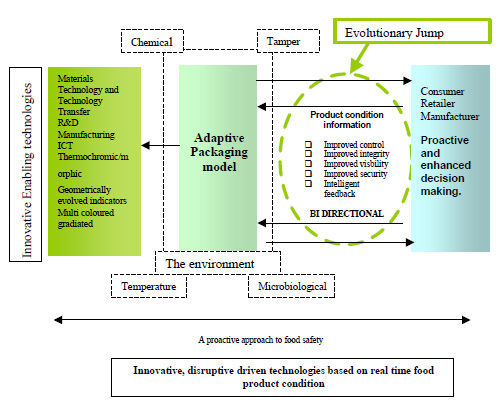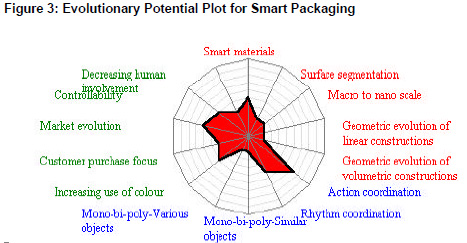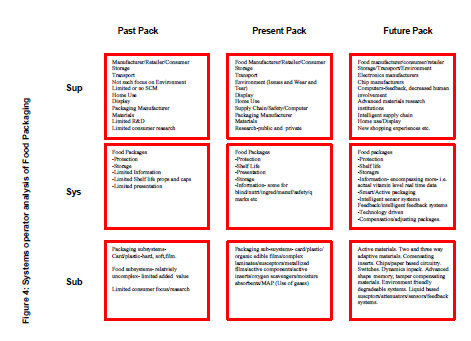Utilising TRIZ Methodologies to Evolve and Develop Next Generation Food Packaging Concepts
Editor | On 14, Jul 2003
Dr John Cooney,
Researcher,
University College Cork, Ireland
Tel: +353 86 1599027
Barry Winkless, MSc,
Research Engineer
University College Cork, Ireland
Tel: + 353 87 9720544.
© Barry Winkless and John Cooney. All rights reserved
The following article focuses on the utilisation of TRIZ methodologies in the generation of new concepts in food packaging. It begins by stressing the crucial importance of food quality and safety in the marketplace and to the consumer. An overview of the state of the art in relation to ‘smart’ packages is then discussed, with reference to the current smart packaging model. Through the use of the TRIZ Technology Trends and the Evolutionary Potential methodology (Mann 2003), this current model is evolved into a next generation CAPE (Conceptual Adaptive Packaging Evolutionary) Model. Future food packaging development directions and innovations are then presented focusing on the evolutionary jump from smart/intelligent to adaptive packages.
INTRODUCTION
The essential mission of a food-manufacturing organisation is to optimise its profitability over time. It deploys its production system, and employs its labour force to add value to raw materials of a relatively low value to transform them into an output of a higher value. The entire organisational systems requires many sub-systems such as production, marketing, sales and packaging to place its product in the market place effectively, efficiently and safely (Cooney, 2001). In the context of packaging, food manufacturing organisation must have the ability to be innovative, and align themselves with the pace of packaging technology change in order to add value to their product.
In the global market, sustained product quality is essential for profitability, survival and growth. The global market assimilates different national preferences into a set of core and non-differential market imperatives (Shi, 1997). To satisfy this new, refined, intensive and universal demand, traditional packaging methods for food products have to be open to continuous qualitative packaging improvement.
Food “safety†is a key characteristic of overall food quality. Food quality is the result of all the desirable characteristics, for example, nutritional value and taste (ITC, 1991) that make food acceptable to eat. In this context, a food manufacturing organisation must take the imperative of corporate performance seriously in order to develop first class products that are free from contamination and meet the specific standards regarding consistency at each stage of the supply chain. Furthermore, consumers want information on product ingredients, what recipes are possible, whether the product can be recycled, and product storage time. Therefore, customers no longer require transparency only in how their food is produced, but they also require visible indicators to enable them to recognise food that is safe for consumption. These trends point for the need to the use advanced packaging technologies that will enable critical important data to be provided to all the actors in the value chain.
Reliability of Food Packaging Information
Lewis (2002) indicated that product “dating†on food packaging is used by consumers to determine when to purchase or use a food product at its best quality, and to help he retailer determine how long to display the product for sale. However, the United States Department of Agriculture (USDA) suggests that these dates are not safety dates. Instead, they should be viewed as more of a good-faith promise of freshness.
According to the Auckland HealthCare Food Safety Quarterly Report (2000) some food businesses are repackaging food and enabling it with the date it was repacked instead of the original date bar. This practice is essentially unsafe as the shelf life information is lost in the packaging. The report also identified that the two major reasons for recalls for the period 1994-1998 were Foreign Matter (including glass and heavy metal) which accounted for 36% of recalls and Microbiological contamination (including Listeria) which contributed for the 23% of total recalls. These findings highlight a definite need for more advanced packaging designs that ensure food product safety and integrity in relation to chemical, microbiological, tampering and foreign matter issues.
Food Packaging
The basic functions of food packaging include the protection of the contents, promotion of convenience, and providing product information (Figure 1). The various packaging concepts include, passive packaging, active packaging, smart packaging, and intelligent packaging.
Figure 1: Mind Map of Food Packaging functions

Brody (2002) highlights that shelf life of food is based on the proportion of consumers that companies are willing to displease at a given time and for the given distribution conditions. It is the period during which the product will retain an acceptable level of eating quality for the given percentage of consumers from a sensory part of view, whilst still maintaining safety. It is further suggested that this depends on four main factors namely formulation, processing, packaging and storage.
Types of packaging
Passive Packaging
Passive packaging provides protection from external elements such as air and moisture.
Active Packaging
Active packaging is an advancement on passive packaging and controls the internal environment of the contents including oxygen and moisture. It may also include features that absorb oxygen, carbon dioxide, moisture, odours into the packaging.
Smart Packaging
Smart packaging uses features of high added value that enhance the functionality of the product, notably mechanical, electronic and responsive ink features, for example electronic and mechanical dispensers in which drugs are supplied and the prepared meal that automatically tells the microwave how it should be cooked. Smart packaging can be categorised into two types, those which incorporate integrated circuits (IC’s) and does which do not incorporate IC’s otherwise known as chipless smart packaging. Packaging that incorporate diagnostic indicators are also included in smart packaging. These can be used for such functions as monitoring vibration, acidity, tilt, shock, humidity, light, heat, time chemicals, virus or bacteria as they develop or as they are contacted.
Intelligent Packaging
Intelligent packaging can be considered to that which includes responsive features such as radio tagging in the form of anti-theft “electronic article surveillance†(EAS) and radio frequency identification (RFID) where data are electronically sensed on the package from a distance. It also include “magic inks†which variously change colour to indicate that unacceptable temperature, time, humidity or other changes have occurred. For example a colour change to confirm that adequate gamma-ray, heat or ethylene oxide sterilisation has occurred or as an indicator when food is fresh or correctly cooked
Current smart packaging technology
Figure 2 illustrates current smart/intelligent packaging technology which can be considered uni-directional in how it provides product condition information to the consumer. This type of consumer information is retrospective with regard to actual food product integrity. The major failing of these packaging systems is that they do not allow the manufacturers and retailers to monitor on a continuous basis the real time condition of the food before it is it purchased at point of sale. Current systems are condition specific with regards to reading temperature, microbiological, chemical and to a degree tampering conditions. In this context the manufacturer, the retailer and the consumer are encouraged to adapt a reactive strategy in relation to food safety at all stages in the value chain.
Current smart/intelligent packaging technology is focused on standard, safe packaging research. For example mono colour indicators, non-feedback product condition information, and non-thermomorphic 2D structures. Our research has identified, using state of the art innovation methodologies that current smart packaging technology is at a relatively un-evolved developmental stage. This would indicate that current technology is lagging behind the requirements imposed on manufacturers and retailers through consumer organisations, EU directives and national regulatory frameworks. Therefore there is a real need for adaptive packaging that safeguards food safety at all stages of the value chain. In TRIZ terms at present smart packaging is carrying out insufficient useful functions with regard to packaging fundamentals.
Evolving the smart packaging model using TRIZ and patent search strategies
After identifying that various insufficient useful functions currently exist in smart packaging technologies, an examination of the current evolutionary state of smart packaging technology using the Evolutionary Potential methodology (Mann 2002) was conducted. It is apparent that smart packaging is still at a relatively early stage in its development (Figure 3).
In conjunction with this process a systems operator analysis was carried out on food packaging in order to ensure that all aspects of the packaging ‘value chain’ were taken into account throughout the duration of this project (Figure 4).
A patent analysis was then carried out focusing on all relevant and potentially related innovations that would help evolve smart packaging. A function related mind map (Figure 5) was generated in order to ensure the patent search covered all potentially fruitful developmental areas (Winkless 2003). Mind-maps are predominantly utilised in mapping the complete solution area in TRIZ related projects. In this case it is used as a means to make the patent search as inclusive as possible.
A full description of the complete patent search strategy and findings will be published in later articles and follows the recommendations made by Winkless (2003) for TRIZ and patent search innovation strategies.
Having analysed the relevant patent findings, it was quickly realised that a significant number of innovative opportunities exist for smart food packaging developers. Many of the search strings covered by the patent search resulted in an identification of definite synergies between future packaging developments and current technologies in other areas such as Materials, Sensor Technolgies and Self and Shape memory alloys.
With reference to the Evolutionary Plot and Patent search startegy, a number of innovation directions and concepts have been developed. The following section highlights the relevant trends and patent inventions in other sectors that could be utilised for the future development of smart packaging. A CAPE (Conceptual Adaptive Packaging) model is then proposed for future R&D projects.
There are definite synergies between shape memory alloys and the evolution of smart packaging materils. Numerous shape memory materials currently available could be utilised in solving the problems of package damage. The potential, for example of a sandwich package that retains its shape, even after being dropped is obvious.
Currently available food packaging indicators generally focus on the measurement of one variable such as temperature. None of the products currently available utilise a gradiated system or a number of different measures on the same package. For example a thermochromic indicator for temperature may read the product temperture as good, even if the package has been tampered with. The potential exists for the development of a multicriteria package measurement that can measure temperature/vitamin content/ and damage to the package film.
At present current package based feedback systems send information back to the computer terminal, for example state of the art in relation to this type of technology is a temperature profile recorder that can be analysed on a computer terminal. A possible evolutionary jump from this current state may involve a sensor mechanism that identifies a long time/temp lag and activates a cooling device either in the pack, or in a batch, or in the room it is being stored in. The same mechanism could send an emergency e-mail to the manufacturers of the food product at any stage throughout the entire food value chain.
Currently existing smart packaging technology depends on sight based indicators. This precludes any benefit to blind, visually or mentally impaired individuals. Recent developments in ‘Thermomorphic adhesives’ could be utilised in the development of package based indicators that utilise the third dimension and the sense of touch. In a different developmental direction and linking in with the addition of feedback, potential exists for numerous consumer packaging feedback products. For example if a consumer is enjoying a Big Mac ™ at McDonalds, after a time dealy, a sensor could activate a film imbued with the odour of a McFlurry, resulting in an increased probability of a McFlurry being purchased by the consumer.
CAPE Model
In light of these potential evolutionary developments, it is apparent that smart packaging could very quickly evolve into ‘Adaptive Packaging’. Figure 6 illustrates the Conceptual Adaptive Packaging Evolutionary (CAPE) proposed Model to improve food safety throughout the value chain through the use of innovative concepts developed by the TRIZ methodology. It is evident from Figure 6 that the incorporation of the innovative enabling technologies and a new research methodology may provide the architecture for an evolutionary packaging technology jump. This evolutionary jump shifts the focus from the current reactive approach to a proactive approach in the management of food safety in the value chain with regard smart packaging technologies.
Figure 6: Conceptual Adaptive Packaging Evolutionary Model

The inclusion of innovative enabling technologies such as thermo chromic, thermomorphic indicators and ICT systems will provide a technological platform from which to develop next generation adaptive packaging systems. At the core of these AFP’s is food safety considerations such as improved visability, control, integrity, security and a new intelligent feedback system.
Conclusion.
The utilisation of TRIZ and patent search strategies has identified that current smart packaging technologies can very rapidly evolve through the use of TRIZ methodologies and currently available technologies from diverse industry sectors. This article represents the first of three articles that will further develop the CAPE model and the use of TRIZ and patent search strategies in the devlopment of innovative and feasable adaptive packaging technologies.
References
Auckland HealthCare, (2000) ‘Decline in Food Recalls-when to involve you public health service’’ Food Safety Advice Food Safety Quarterly Report. Sept 2002
Brody, A.L., (2002) ‘2002 IFT annual meeting and IFT Food Expo Preview’,
Packaging, Food Technology, 56,5 p112-115.
Cooney, J.M.M., (2001), Development and Application of Condition Based
Maintenance and Management in Food Manufacturing, Ph. D Thesis,
Department of Process Engineering, Faculty of Engineering, NUI,
Cork, Ireland.
Mann, D (2002) ‘Hands on Systematic Innovation’, CREAX PRESS. 2002.
Shi, Y., (1997), International manufacturing Configuration Map: A Selfassessment
Tool of International Manufacturing Capabilities, Integrated
manufacturing Systems, , MCB University Press, Vol. 8, No.5, pp 277-280.
Winkless, B (2003) ‘Systematic innovation and technology managament: An
analysis and application study utilising TRIZ methodologies and patent
serarch strategies’. PhD Thesis (to be completed), Dept of Process
Engineering, NUI, Cork, Ireland.
ALL TREND GRAPHICS USED IN THIS PAPER ARE FROM CREATRIZ 3.0
AND ARE © CREAX n.v.









